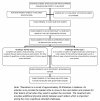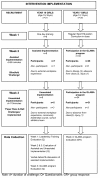The GLAMA (Girls! Lead! Achieve! Mentor! Activate!) physical activity and peer leadership intervention pilot project: a process evaluation using the RE-AIM framework
- PMID: 22260195
- PMCID: PMC3293770
- DOI: 10.1186/1471-2458-12-55
The GLAMA (Girls! Lead! Achieve! Mentor! Activate!) physical activity and peer leadership intervention pilot project: a process evaluation using the RE-AIM framework
Abstract
Background: Implementing new initiatives and physical activity interventions in schools represents a myriad of challenges that if overcome can potentially facilitate a range of behavioural changes. The aim of this paper is to describe the process evaluation of specific design constructs used in the GLAMA (Girls! Lead! Achieve! Mentor! Activate!) peer leadership and physical activity pilot project. Conducted in a state secondary school in Australia, the intervention was designed to provide students with opportunities to develop leadership skills, school and social connectedness in addition to a range of physical activity experiences.
Methods: This process evaluation used the RE-AIM (Reach, Efficacy, Adoption, Implementation and Maintenance) health promotion evaluation framework to assess three design constructs of the intervention: the effectiveness of leadership training and leader preparedness, activity suitability and participation, and the barriers to implementation of the intervention and potential solutions to overcome these barriers. As it was not the specific aim of this pilot, no behavioural change data were collected from students. Data were collected using a mixed methods approach including student questionnaires, teachers and researchers reporting on their own observations and feedback from students.
Results: There were three main considerations evident across more than one RE-AIM dimension that need to be addressed to assist with future GLAMA dissemination. Firstly, the development of teacher, school and student participation. This needs to be through a variety of professional development opportunities for teachers, integration of the program within timetabled classes within the school and promoting the program to students as an opportunity to develop a range of skills to apply to future learning and workplace environments. Secondly, the successful translation of leadership training to practice is necessary to ensure that leaders are effectively able to motivate, facilitate and activate their teams. Finally, the need for consistent activity implementation requires sequential, competitive elements, purposeful team selection and clearly defined scoring and time periods for team 'challenges'.
Conclusions: Factors that have the greatest impact on intervention success are those that come from within the school setting including: the structure of the curriculum, pressure to meet curriculum and assessment content, lack of support for new initiatives, multiple programs already running within the school, time allowances for teachers, appropriate training for teachers, and support for students to participate. These barriers need to be considered when developing all secondary school interventions.
Figures
References
-
- Naylor PJ, McKay HA. Prevention in the first place: schools a setting for action on physical inactivity. Br J Sports Med. 2009;43(1):10–13. - PubMed
-
- Pate RR, Davis MG, Robinson TN, Stone EJ, McKenzie TL, Young JC. Promoting physical activity in children and youth: a leadership role for schools. A scientific statement from the American Heart Association Council on Nutrition, Physical Activity, and Metabolism (Physical Activity Committee) in collaboration with the Councils on Cardiovascular Disease in the Young and Cardiovascular Nursing. Circulation. 2006;114(11):1214–1224. doi: 10.1161/CIRCULATIONAHA.106.177052. - DOI - PubMed
-
- van Sluijs EMF, McMinn AM, Griffin SJ. Effectiveness of interventions to promote physical activity in children and adolescents: systematic review of controlled trials. Br J Sports Med. 2008;42(8):653–657. - PubMed
Publication types
MeSH terms
LinkOut - more resources
Full Text Sources
Research Materials



